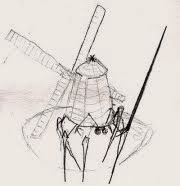Snows gone, so I refilled my Farmall's gas tank and tried to start up.
Immediate problem - fuel running out of the carburetor and air intake hose.
Obviously the gaskets were shot. I pulled the carb off to discover it was rustier on the inside than the out. Thick layers of ferric oxide lay on every surface. It was blind luck that I hadn't cranked the motor over and dragged all that crapped into the cylinders.
Being a little put-off by the prospect of sanding the whole thing clean,I turned to electrolytic anti-oxidation.
Three tablespoons of washing soda in a gallon of water, a chunk of rusty band saw blade as the sacrificial anode.
Out came my handy little 6 amp battery charger.
Up came the little bubbles, streaming off the electrodes.
Worked like a charm. Three hours took off nearly all the rust, and just about every bit of grease and sludge was scrubbed away as well. The electrolyte is a nasty rust orange, now.
Two interesting things happened though, possibly due to the fact that I was using a heavily scented 'washing soda' form of sodium carbonate.
First, the sacrificial anode grew the expected chunks of rust. What I didn't expect were clusters of green-blue crystals. They grew to about 0.5 - 1 mm in diameter over several hours.
Copper contamination in the washing soda?
Second, the gas bubbling off the electrodes should have been pure H2 and O2. Harmless except to inveterate smokers.
I couldn't smell anything (Sinuses clogged) but breathing over the tank while watching it work gave me a faint but noticeable chest pain. Perhaps some chlorine mixed into the output?
I used a stainless steel strainer to hold all the carb's small parts. Half an hour cleaned them up nicely, and the carb lies re-assembled on my dinner table, the size and shape of a human heart.
Weird similarity, there.
Labels:
Carburetor,
electrolytic derusting,
Farmall,
heart
Subscribe to:
Comments (Atom)

